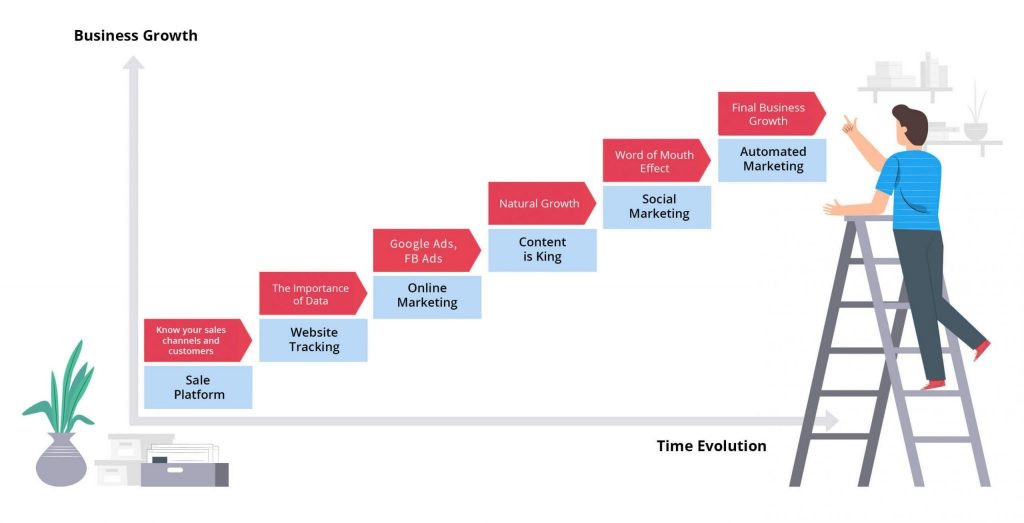
In today’s digital landscape, small businesses have an unprecedented opportunity to achieve substantial growth through strategic digital marketing
However, navigating the vast array of digital marketing channels and tactics can be overwhelming. That’s where a well-defined digital marketing blueprint comes into play. This article outlines a roadmap for small business growth through a comprehensive digital marketing strategy, empowering entrepreneurs to effectively reach their target audience and drive sustainable success
Set Clear Goals and Objectives:
The foundation of any successful digital marketing blueprint lies in setting clear goals and objectives. Identify what you want to achieve through your digital marketing efforts, such as increasing website traffic, generating leads, or boosting online sales. Ensure that your goals are specific, measurable, attainable, relevant, and time-bound (SMART), allowing you to track progress and adjust strategies accordingly.
Know Your Target Audience:
Understanding your target audience is essential for crafting personalized and effective digital marketing campaigns. Conduct thorough market research to identify your ideal customers’ demographics, interests, pain points, and online behavior. Develop detailed buyer personas that encompass their characteristics and preferences. This knowledge will guide your content creation, messaging, and channel selection to ensure maximum resonance with your target audience.
Build an Optimized Online Presence:
Create a professional and user-friendly website that serves as the centerpiece of your digital marketing efforts. Optimize your website for search engines, ensuring it ranks high in relevant search results. Incorporate keyword-rich content, optimize meta tags, and enhance site speed for a seamless user experience. Additionally, establish a presence on relevant social media platforms to engage with your audience, drive brand awareness, and foster customer loyalty.
Craft Compelling Content:
Content is the driving force behind successful digital marketing campaigns. Develop a content strategy that aligns with your target audience’s needs and interests. Create high-quality blog posts, articles, videos, infographics, and podcasts that provide value, educate, and entertain. Tailor your content to different stages of the buyer’s journey, from awareness to consideration and conversion. Consistently produce and distribute content across various channels to enhance brand visibility and establish thought leadership.
Implement Search Engine Optimization (SEO):
To maximize organic visibility and drive relevant traffic to your website, employ effective search engine optimization strategies. Conduct keyword research to identify popular search terms in your industry. Optimize your website’s content, headings, meta tags, and URLs with these keywords. Focus on providing valuable and user-friendly content that aligns with search intent. Regularly monitor your website’s performance using analytics tools and make necessary optimizations based on data insights.
Embrace Social Media Marketing:
Leverage the power of social media platforms to connect with your target audience and amplify your brand reach. Select the platforms where your audience is most active and develop a cohesive social media marketing strategy. Create engaging and shareable content, actively engage with your followers, and foster authentic relationships. Leverage social media advertising options to reach a wider audience and target specific demographics or interests.
Harness Email Marketing:
Email marketing remains one of the most effective channels for nurturing leads, driving conversions, and building customer loyalty. Develop an email marketing strategy that encompasses personalized and targeted campaigns. Segment your email list based on demographics, preferences, and engagement levels. Deliver relevant and valuable content, such as exclusive offers, informative newsletters, or personalized recommendations. Continuously analyze campaign metrics and optimize your email marketing efforts based on customer responses and behavior.
Monitor, Analyze, and Optimize:
Regularly monitor and analyze the performance of your digital marketing campaigns to gain actionable insights. Utilize analytics tools to track website traffic, user engagement, conversion rates, and campaign ROI. Measure the effectiveness of your strategies and make data-driven decisions to optimize performance. Identify areas for improvement and experiment with new tactics and channels to stay ahead of the competition.
Conclusion:
A well-executed digital marketing blueprint can pave the way for small business growth and success in today’s competitive landscape. By setting clear goals, understanding their target audience, building an optimized online presence, crafting compelling content, implementing SEO techniques, embracing social media marketing, harnessing email marketing, and continuously monitoring and optimizing their strategies, small businesses can thrive and achieve their desired outcomes. A comprehensive digital marketing roadmap is the key to unlocking the full potential of digital channels and propelling small businesses towards sustainable growth.

